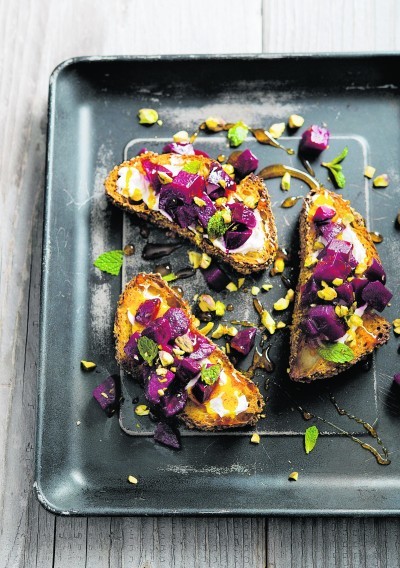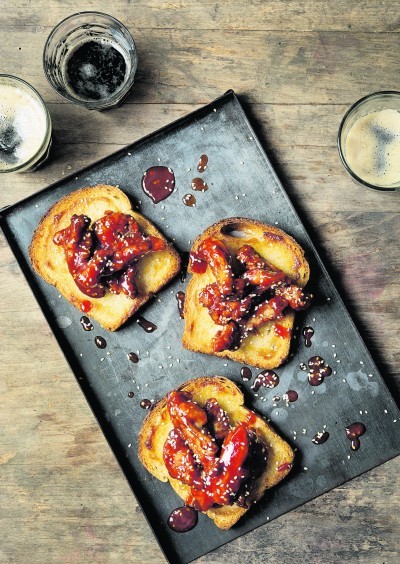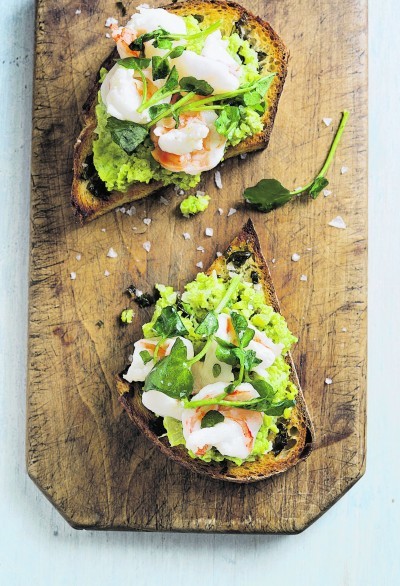If you love toast, but yearn for something more exciting than beans to put on it for dinner, then Raquel Pelzel is worth listening to.
The US-born food writer has devoted an entire book to the topic of toast and perfect toppings – and as Toast: The Cookbook proves, the possibilities are endless, providing you’re willing to put a little effort in and get creative.
“When I was thinking about writing my own cookbook, I was looking for a topic that would allow me to really have fun and explore a lot of different flavours and foods that I know so much about through all my previous collaborations,” explains Pelzel, who spent 12 years co-authoring and ghost-writing cookbooks with other chefs.
“I was thinking about trends and what was happening in New York, LA and Chicago, and something that came up time and time again was toast.
“Toast – not with eggs for breakfast – but toast as this really elegant, elevated starter or second course that I was starting to see a lot at cafes and in restaurants.”
And it turns out serving up the perfect slice is more involved than you might think. Pelzel put a lot of thought into deciding how she wanted to tackle the toast component of her recipes, in the end electing to let the reader decide what bread to use for most of them.
“It was a huge consideration, actually. The kind of bread you use hugely impacts the finished dish. A rye bread or semolina bread? A fruit nut bread or sourdough or ciabatta? They all have a different texture, a different chew and different flavours once they’re toasted,” she explains.
“But when I was putting the book together, I didn’t want people to feel, ‘Oh, I can’t get to the artisan bakery at the other side of town to pick up this ridiculously specialised bread’, so I decided to say, ‘Use whatever you happen to have in the house as, in all honesty, most breads work beautifully for toast’.”
But her dream slice is a sourdough loaf: “It has a really nuanced and a little bit of a sour flavour, and makes the most beautiful toast, because there’s so much flavour from the bread itself.”
The thickness of the slice – and toasting method – are also vital.
Tempted to tart up some toast of your own? Here are three of Pelzel’s recipes to try:
ROASTED BEETS ON TOAST WITH LABNEH AND SAFFRON HONEY
- SERVES 4
- TO MAKE THE SAFFRON HONEY AND ROASTED BEETS:
- 1/2tsp saffron threads
- 120ml honey
- 1/4tsp, plus a pinch, of coarse salt
- 3 medium beetroots, ends trimmed
- 2tbsp extra-virgin olive oil
- 2tsp finely chopped fresh mint leaves
- Freshly ground black pepper
- FOR THE TOAST:
- Four 3/4inch-thick slices of country-style bread
- 240ml labneh (Lebanese-style) yogurt or plain Greek yogurt
- 4tbsp toasted and roughly chopped pistachios
- Flaky salt
Make the saffron honey: Toast the saffron in a small skillet (frying pan) over medium heat, shaking the pan often, until the saffron is fragrant – this should take 30 seconds to one minute.
Transfer the saffron to a small dish and use the back of a teaspoon to crush it into a fine powder. Add the honey to the skillet and bring it to a simmer over medium heat. Stir in the saffron and a pinch of salt, remove from the heat, and set aside.
Roast the beetroots: Preheat the oven to 190C/Gas 5. Set each beetroot in a large square of foil and drizzle one teaspoon of the oil over the top of each.
Wrap the beetroots in the foil, place on a rimmed baking sheet, and roast until a paring knife easily slides into the centre of the largest one, which should take about one hour. Remove from the oven and set aside for 20 minutes before unwrapping.
Once the beetroots are cool enough to handle, peel them and chop into bite-size pieces. Toss the beetroot pieces with one tablespoon of the oil, the mint leaves, quarter teaspoon of salt, and the pepper and set aside.
Make the toast: Toast the bread to your own taste, be it in a traditional toaster, under a grill, on a barbecue, in a mini oven, pan fried or shallow fried. Let the toasts cool for a few minutes before topping.
To serve, spread each toast with labneh. Top with beets, pistachios, a generous drizzle of saffron honey, and flaky salt.
SESAME AND HONEY BARBECUE FRIED CHICKEN TOAST
- SERVES 4
- FOR THE FRIED CHICKEN:
- 240ml buttermilk
- 2 1/2tsp coarse salt
- 1/2tsp garlic powder
- 1/2tsp freshly ground black pepper
- 1/2tsp sweet paprika
- 680g boneless, skinless chicken thighs, halved crosswise or cut into strips
- 125g plain flour
- 50g cornflour
- 3tbsp barbecue sauce
- 2tbsp ketchup
- 2tbsp honey
- 1-2tbsp hot sauce
- 950ml-1.2L rapeseed oil
- 2tbsp toasted sesame seeds
- FOR THE TOAST:
- Four slices sandwich bread
- 3tbsp mayonnaise, for the bread
- Coarse salt, for the bread
Make the fried chicken: In a medium bowl, whisk together the buttermilk, two teaspoons of the salt, the garlic powder, pepper, and paprika. Add the chicken thighs, cover, and refrigerate for one hour or overnight.
In a large bowl, whisk together the flour, cornflour, and remaining half teaspoon of salt. In another large bowl, whisk together the barbecue sauce, ketchup, honey, hot sauce and set aside.
Remove the chicken from the buttermilk (discard the marinade). Add the chicken to the flour mixture and turn to coat. Set aside while you heat the oil.
Set a wire rack over a baking sheet lined with paper towels or paper bag. In a large, deep, heavy-bottomed skillet (frying pan), heat the oil over medium-high heat until an instant-read thermometer reads between 180-185C. Add half of the chicken pieces and fry until both sides are golden brown and the chicken is cooked through, around four to five minutes per side. Use tongs to transfer the chicken to the wire rack to drain and fry the remaining chicken.
Make the toast: Spread the bread slices with the mayonnaise and sprinkle with salt. Toast the bread using your preferred method (Pelzel recommends grilling or pan frying). Note that mayonnaise browns faster than butter or oil, so keep a close eye on the toast to make sure it doesn’t burn. If pan-frying, you don’t need to melt butter or add oil to the pan first – the mayo coating on the bread is sufficient for browning.
Place the fried chicken in the bowl with the barbecue sauce mixture and toss to coat. Sprinkle with sesame seeds, place one or two chicken pieces on top of each piece of toast, and serve.
SWEET SHRIMP AND FAVA SMASH TOAST
- SERVES 4
- FOR THE TARRAGON BUTTER AND FAVAS:
- 60g unsalted butter, softened
- 1tbsp finely chopped fresh tarragon leaves
- 1 3/4tsp, plus a pinch, of coarse salt
- 225g shelled fava beans (from 910g-1.1kg favas in the pod) – or if you prefer, you can use peas
- 1 1/2tbsp extra-virgin olive oil
- 1/2 sweet onion (such as a Vidalia), finely chopped
- 2tbsp double cream
- FOR THE TOAST:
- 15g unsalted butter
- 225g large prawns, shelled, deveined, and halved lengthwise
- Coarse salt
- Juice of 1/2 lemon
- Four 3/4inch-thick slices country-style bread
- Flaky salt
- A few handfuls of watercress or baby spinach
Make the tarragon butter: In a small bowl, mix together the butter, tarragon, and a pinch of course salt. Set aside.
Make the favas: Fill a small bowl with ice water and set aside. Bring a small saucepan of water to a boil. Add one teaspoon of the salt and the fava beans and blanch the favas for one minute. Drain and shock favas in the ice water.
Once the favas are cool, use your finger and thumb to pinch and slip off the skins. Place the skinned favas in a small bowl. (If using peas instead of favas, skip this step entirely)
In a medium skillet (frying pan), heat the oil over medium heat. Add the onion and half a teaspoon of the salt and cook, stirring occasionally, until the onion is soft, for five to six minutes. Stir in the fava beans and cook until they are tender, for three to five minutes.
Transfer the mixture to a food processor, add the cream, one tablespoon of the tarragon butter, and the remaining quarter teaspoon of salt, and process until smooth.
Make the toast: In a medium skillet, melt the butter over medium heat. Add the prawns and cook slowly, spooning the butter over the shrimp, until they start to curl, for about one minute.
Season to taste with salt, turn the shrimp over and cook on the other side until they are cooked through, about one minute longer. Transfer to a medium bowl and toss with the lemon juice.
Spread the bread slices with the remaining tarragon butter and sprinkle with flaky salt. Toast the bread as you wish (Pelzel recommends grilling, barbecuing or toasting in a mini oven).
To serve, top each toast with a generous amount of fava smash. Add the cress to the prawns and toss to combine, and then spoon it over the fava smash. Sprinkle with flaky salt.



